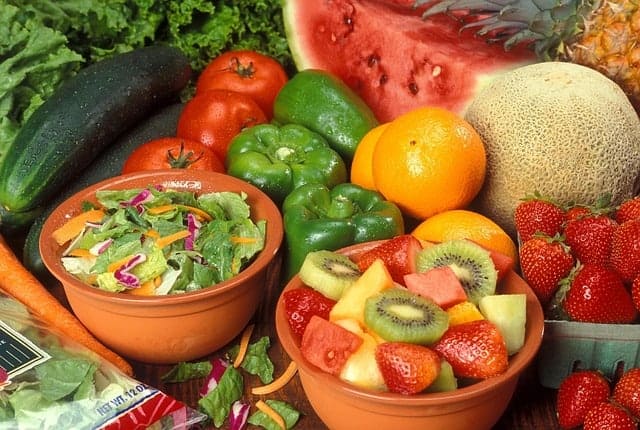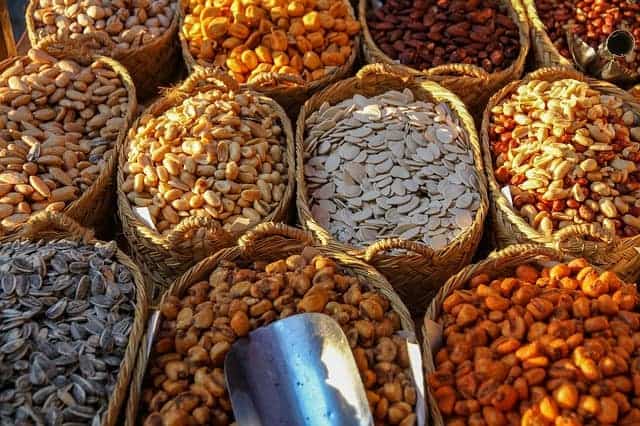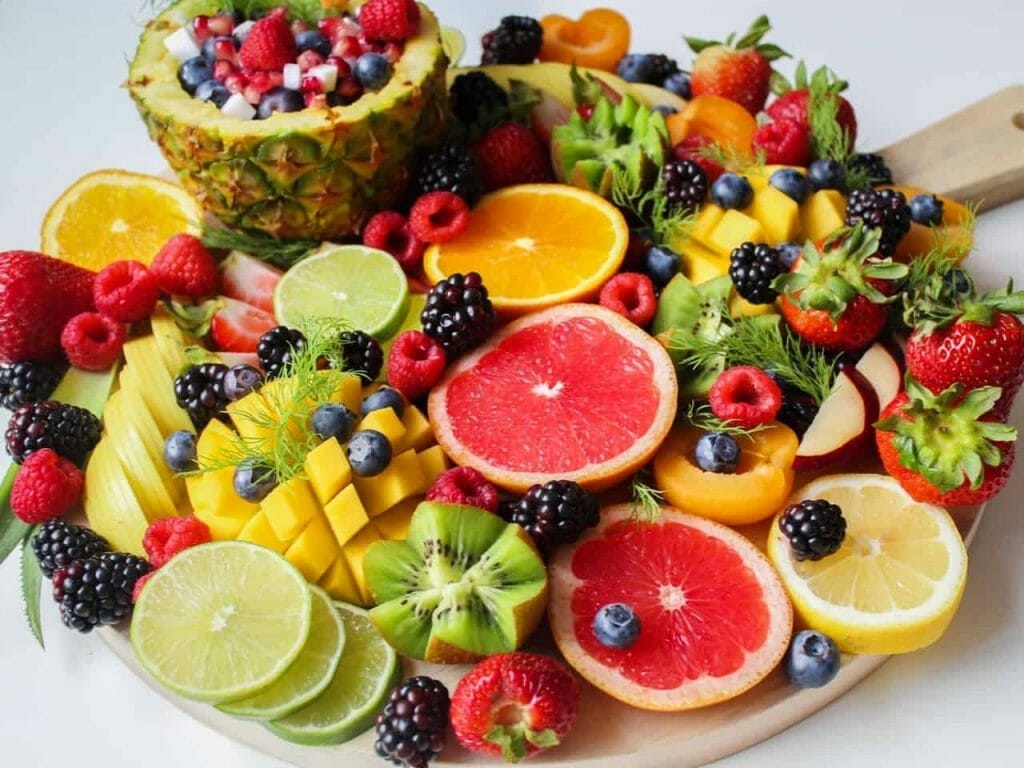A diet for varicose veins and spider veins on legs is extremely important in this type of diseases because unhealthy eating habits and overweight largely contribute to excessive enlargement of blood vessels. And although we have no influence on the inherited tendency to develop varicose veins, their prevention and blocking the further progression of the disease significantly depend on lifestyle and a proper diet. It should be varied, but low in calories, provide the body with vitamins, minerals and fibre, contain little salt and no trans fats.
Table of contents
- 1 How do spider veins and varicose veins develop?
- 2 Can lifestyle and diet help in the fight against spider veins and varicose veins?
- 3 The varicose vein diet – the essential goals
- 4 Diet for varicose veins and spider veins on legs – tips on menu
- 5 Dietary supplements – additional support of the diet for lower limb varicose veins
How do spider veins and varicose veins develop?

The problem usually starts with circulation disorders manifested by the feeling of heavy legs, pain and cramps in the calves, swelling around the ankles, the need to frequently move legs while sitting or standing. The next stage is the appearance of so-called spider veins, i.e. dilated blood vessels forming a specific network spreading from one point, expertly referred to as telangiectasia. Over time, this process intensifies and permanent vein dilatation or varicose veins – twisted bulges of sinuous purple colour – become visible on the legs. They are accompanied by increasing swelling around the ankles.
The primary cause of such anomalies is the disruption of vascular contraction and relaxation mechanisms and venous valve insufficiency. They lead to backflow of blood, its stasis and increase in pressure in vessels, which in consequence causes an unnatural expansion of vein walls and creation of deformed venous vessels. Venous insufficiency, which initially goes almost unnoticed, can cause life-threatening consequences – deep vein thrombosis and congestion.
Can lifestyle and diet help in the fight against spider veins and varicose veins?
Apart from genetic factors, acquired predispositions significantly contribute to circulation disorders in lower limbs. This mainly concerns the type of work, i.e. prolonged sitting or standing in one position, lack of physical activity or excessive physical strain, improper diet and overweight, high blood pressure, pregnancy and hormonal treatments, excessive exposure to sunlight, alcohol and smoking.
Contrary to appearances, an appropriate diet and, consequently, getting rid of excess kilograms, has a significant influence on the prevention of circulatory disorders and may significantly inhibit further progress of the disease, if we have already been unlucky enough to experience it. This is all the more important because it will help reduce the importance of genetic load and will generally promote our health.
The varicose vein diet – the essential goals

Today probably no one doubts that even the most modern achievements of medicine in the fight against various diseases, must be supported by activating the natural defense forces of the body. Similarly to many other diseases, in the case of spider veins and varicose veins we can do this by radically changing our diet and providing the body with substances conducive to its regeneration. Here are the goals we should achieve:
Strengthening the walls of the veins
Improper diet has a negative impact on the functioning of the entire body, including the condition of veins, which, weakened, are more susceptible to stretching and damage. Therefore, the menu should be enriched with products containing substances that strengthen blood vessels. It is mainly bioflavonoids (otherwise known as flavonoids), i.e. compounds of plant origin, which show a number of beneficial health properties.
Flavonoids have antioxidant and anti-inflammatory properties; they also strengthen and seal vein walls. Similar effects are observed in vitamins, especially vitamin C, which additionally stimulates collagen production, which also contributes to strengthening of blood vessels.
A diet for varicose veins and spider veins on the legs can also not do without other vitamins and minerals, as well as Omega 3 unsaturated fatty acids. These acids have anti-inflammatory and anticoagulant effects, regulate blood pressure and reduce the risk of venous congestion.
Achieving or maintaining a healthy body weight
Overweight, and especially obesity, are extremely detrimental to the body as a whole. Excess weight also means a huge burden on the circulatory system, as it increases blood pressure in the legs, which promotes circulatory disorders and venous insufficiency. It will be possible to lose weight if you change your eating habits – give up sweets, processed foods and fatty and fried foods, and in place of them introduce whole-grain cereal products, bran, oatmeal, thick groats, large amounts of vegetables, fruit, lean meat and fish, seeds and seeds into your diet.
Read also: Body detox – the way to health, well-being and a shapely figure
Prevention of constipation
Improper diet, low in fibre, liquids and vegetable products and rich in sugars and trans-fats often results in constipation. They are dangerous in the case of venous circulation disorders, because they increase pressure in the abdominal cavity, as a result of which compressed veins find it difficult to let blood through, which starts to back up in the lower limbs. Even the use of laxatives does not solve the problem, because they work temporarily, eliminating the effects, not the causes.

So what products should be included in the daily menu? Vegetables and whole grain cereal products are the basis of a valuable diet, which contributes to strengthening capillaries and veins, and at the same time to slim figure and good intestinal peristalsis. In this way, we provide the body with valuable vitamins, flavonoids, polyphenols, fibre and other important substances dilating blood vessels and facilitating blood flow.
Vegetables and fruits containing vitamin C
This extremely important vitamin for many vital processes, which also plays an important role in blood clotting, strengthening blood vessels and collagen production, can be found in black currants, rose hips, strawberries, citrus fruit, red pepper, sauerkraut, Brussels sprouts, spinach, parsley, horseradish, cauliflower, potatoes, among others.
Sources of vitamin E
Called the vitamin of youth, vitamin E is a powerful antioxidant that prevents cell degeneration and aging. Its sources include dairy products, vegetable oils, cereal bran, nuts, almonds, and seeds.
Vitamin PP
Present in cereal grains, nuts or meat vitamin PP, participates in the production of red blood corpuscles, expands blood vessels, in addition, normalizes the level of cholesterol.
Flavonoids
These substances of plant origin significantly strengthen the walls of blood vessels, minimize the risk of their cracking and permeability, and thus prevent swelling. The most important flavonoids in the context of circulatory disorders are hesperidin, diosmin, and rutin. They occur mainly in citrus fruits, but also in peppermint and St. John’s wort leaves. Buckwheat groats, chokeberry, sorrel, elderberry are also a source of rutin. Anthocyanins contained in blue and red coloured vegetables and fruits, blueberries, blueberries, plums, blackberries, cherries, red beans, red cabbage are also very important for the cardiovascular system.
Check also: Health-promoting properties of quercetin
Products rich in fibre
Fiber not only regulates digestion and provides many valuable substances, but also promotes weight loss. As it swells in the stomach, it causes a feeling of satiety, thus reducing appetite. Rich sources of fibre are vegetables, which are low in calories, wholemeal cereals (wholemeal bread, groats, dark rice, cereal flakes and bran), fruit, pumpkin seeds and sunflower seeds.
Unsaturated fatty acids
In contrast to the extremely unhealthy so-called trans fats, Omega3 unsaturated fatty acids have an anti-inflammatory and anti-coagulant effect, lower the level of triglycerides, reduce the risk of embolism, normalize blood pressure. They are found primarily in marine fish, canola and flax oils, egg yolks, nuts, and avocados.
Polyphenols
Polyphenols found in green tea and cocoa, among others, are substances protecting the heart and cardiovascular system, with strong antioxidant and anti-inflammatory effects, blocking the accumulation of atherosclerotic plaques.
Silicon
It is a seemingly unimportant, but in fact playing an important role, nutrient. When there is an insufficient amount of it in the body, blood vessels lose their elasticity, become fragile and burst. Sources of silicon are grains, fruit peels, chives and garlic.
Dietary supplements – additional support of the diet for lower limb varicose veins
In addition to changing your diet and lifestyle, it is worth helping yourself with special supplements containing substances that improve the circulatory system and soothe vascular changes. The most popular substance fighting varicose and spider veins is escin, found in horse chestnut fruits. Hence the wide application of horse-chestnut extract in various preparations addressed to people with venous insufficiency.
Aescin seals and strengthens blood vessels, reduces edema and alleviates pain, exhibits anticoagulant properties. Witch hazel has a similar effect. Regardless of whether you decide on a varicose vein pill or gel for external use, it is therefore worth looking for a product that contains both of these substances.
Read also the review of diet supplement for varicose veins with horse chestnut and witch hazel: Varicorin

